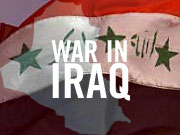Your Voice
| ||||||||||||||||||||||||
Pentagon says combat in Iraq is 'essentially over'
April 14, 2003
Washington, DC — Iraqi fighters have not mounted "a coherent defense" and major combat there is essentially over, an Army major general said Monday.
"I think we will move into a phase where it is smaller, but sharp fights," Maj. Gen. Stanley McChrystal told reporters during a Defense Department briefing.
Two U.S. Navy aircraft carriers and the ships in their battle groups will leave the Persian Gulf this week and return to their home ports, he added.
While there is still a lot of work to be done, McChrystal said, "I would anticipate that the major combat operations are over."
The departure of the USS Kitty Hawk and the USS Constellation reflects a winding down of the air campaign, although the Pentagon is still sending more ground forces to Kuwait and Iraq.
McChrystal said Monday was the last day that aircraft from all five carriers would fly missions over Iraq. The number of missions flown is down to about 800 a day, with fewer than 200 precision-guided bombs and missiles dropped.
Also, there have been no positive test results on the suspected chemical weapons found by coalition forces, McChrystal said.
The Army's 1st Armored Division is moving its equipment to ports for shipment to the Gulf region, and its troops will follow by air in a couple of weeks, a division spokesman, Maj. Scott Slaten, said Monday. The division is sending two armored brigades and one aviation brigade from bases in Germany, and one brigade is going from its base at Fort Riley, Kan., Slaten said.
It is not clear whether one of the Army divisions already in Iraq will leave once the 1st Armored gets there.
Also, soldiers from the 4th Infantry Division, recently arrived in Kuwait from Fort Hood, Texas, crossed the border into Iraq on Monday. First to go were two convoys of about 500 tanks and other vehicles. It was not clear whether their destination was Baghdad or northern Iraq.
The Kitty Hawk will return to its base at Yokosuka, Japan, and the Constellation will return to San Diego, the official said, speaking on condition of anonymity.
As combat winds down in Iraq, the hunt for chemical and biological weapons or nuclear materials is rising on the priority list for American troops. There are more potential nuclear, biological or chemical weapons sites in Iraq than U.S. military teams to check them, Pentagon officials said Sunday.
Also, the United States is focusing on unfinished business from the 1991 Gulf war. A team of experts from the Defense Intelligence Agency and the Central Intelligence Agency have arrived in the Persian Gulf region to search for clues to the fate of Navy pilot Michael Scott Speicher, who was shot down on the first night of that war, U.S. defense and intelligence officials said Monday.
The Pentagon originally declared Speicher killed in action, but changed his status to missing-in-action, then to "missing-captured," after an Iraqi defector and others reported that an American was being held in Iraqi President Saddam Hussein's prison system.
With respect to movements of aircraft carriers, Vice Adm. Timothy Keating, commander of all naval forces participating in the Iraq war - including two carriers in the eastern Mediterranean - had said in an interview Saturday that he hoped the Kitty Hawk and Constellation could leave soon, although he said no orders had been received.
The Kitty Hawk is scheduled to leave first, around the middle of this week, followed shortly by the Constellation, the defense official said.
That will leave only one carrier in the Gulf - the USS Nimitz, which just arrived to relieve the USS Abraham Lincoln. The Lincoln is headed back to its homeport of Everett, Wash.
Keating said Saturday that either the USS Theodore Roosevelt or the USS Harry S. Truman battle groups - both in the eastern Mediterranean for air missions over northern Iraq - may be sent home soon.
Officials said Monday it was not clear whether any decisions had been reached on those carriers.
Each aircraft carrier has about 80 planes aboard, and their F/A-18 and F-14 strike aircraft played a major role in the air war. Surveillance and other support aircraft also fly off the carriers.
The first ship to leave the war zone was the USS Portland, part of an amphibious task force that carried 7,000 Marines to Kuwait in February. The Portland arrived at Little Creek, Va., on Friday.
The Air Force already has sent four B-2 stealth bombers back home to Whiteman Air Force Base, Mo., officials said. They were flying missions over Iraq from the Indian Ocean island of Diego Garcia and from Fairford air base in Britain. Other B-2s flew roundtrip missions from Whiteman.
After the Kitty Hawk deployed to the Gulf in February, its duties in the Pacific were taken up by the USS Carl Vinson, which remains in the Japan area and may stay even after the Kitty Hawk gets back if the carrier requires significant amounts of maintenance, officials said.
(Copyright 2003 by The Associated Press. All Rights Reserved.)
|
News Headlines
|
Related Subjects
|

